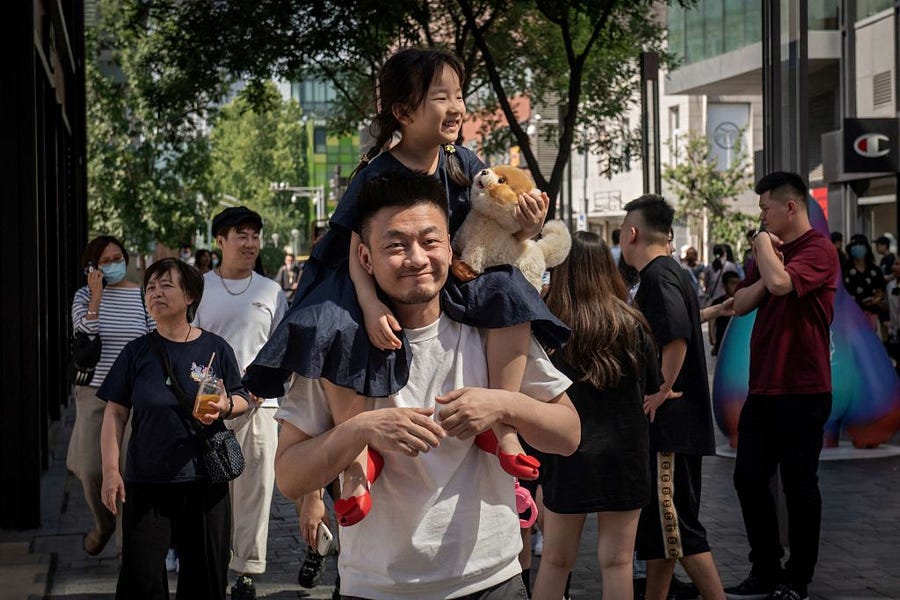For the 2019 Lunar New Year, the Chinese Communist Party (CCP) selected a design for its government-issued stamps that raised eyebrows across the region: The stamp featured two happy adult pigs presiding over a brood of three smiling piglets.
The design created a buzz, leading to speculation by citizens and demographers alike that the government was on the brink of again loosening its family-planning policy.
But it took until 2021, under the shadow of a census showing China’s birth rate has continued to decline, for the CCP to formally announce that all married couples could now have up to three children. Demographers say the policy change may have some short-term impact but is unlikely to substantially right the country’s demographic challenges. Chinese officials are likely to implement other pro-natal policies in the coming years to address the looming difficulties presented by an aging population and diminishing workforce.
“This policy change will make little difference in China’s fertility rate because relatively few Chinese families desire to have three kids under any policy regime,” Lyman Stone, a demographer and adjunct fellow at the American Enterprise Institute, told The Dispatch. “It remains prohibitively costly to have and raise children in China under prevailing policies and social norms.”
The CCP instituted a “one-child” policy in 1980 to dampen population growth and facilitate an economic boom. In part, this was due to concerns that the burgeoning population would overtake the food supply. In the 1950s, Mao Zedong ushered in his “Great Leap Forward,” a centrally executed government plan to rapidly industrialize China’s largely agrarian economy. A devastating famine resulted, killing tens of millions of the country’s citizens between 1959 and 1961. After that, the government began promoting birth control and later marriages. In 1980, the one-child policy, which primarily applied to members of China’s ethnic Han majority, took things further.
For nearly three decades, the bureau tasked with enforcing the government’s family planning policies would carry out its mission in ways that often violated human rights and sparked international criticism. In addition to steep fines and social pressure, officials forced women to get abortions and sterilized those who broke the rules. The policy also resulted in a gender imbalance: A preference for male babies resulted in about 119 boys being born for every 100 girls.
Experts are divided on how much of an impact the one-child policy had on China’s population. Some say the CCP’s aggressive enforcement did its work too well, and China is to blame for its own demographic imbalances.
Other experts say that the trends of urbanization and the rising cost of living would have resulted in diminishing birth rates regardless, similar to trends seen in Western nations. Nicholas Eberstadt, a demographer at the American Enterprise Institute, noted to The Dispatch that surrounding East Asian countries, such as Japan, Singapore, and South Korea, do not have strict family planning controls but show similar low levels of fertility.
Regardless, in a tacit recognition of emerging demographic challenges, the CCP has begun relaxing its family planning policies. In 2020, the number of Chinese aged 60 and older was 18.7 percent of the population, up from 13.3 percent in the 2010 census. This growing share is placing pressure on the country’s pension system. China’s retirement age is only 60 for men, 55 for female white collar workers, and 50 for female blue collar workers.
In 2013, Chinese officials allowed couples to have two children if one of the parents was an only child. In 2015, the city of Beijing allowed all couples to have two children. In 2016, the government formally raised the one-child limit to two. But a hoped-for baby boom fell short of expectations. Births rose only mildly in 2016 and have fallen in the years since.
“Birth totals as reported ticked up slightly the year after the suspension of the one-child campaign,” Eberstadt said. “But since then it’s plunged—gone down year after year after year.”
The 2021 census confirmed that trend. The once-in-a-decade count reported 12 million babies born in China over the last year, a drop in births for the fourth consecutive year. In 2016, there were 17.86 million births reported.
Eberstadt added that obvious complicating factors likely drove down the births in 2020: “2020 was somewhat of an anomalous year given the once in a century [COVID-19] pandemic crisis. But if we match [reported births] up with births of 2016 we see a drop of almost a third.”
The overall population did show a small increase, from 1.4 billion in 2019 to 1.41 billion in 2020.
Despite the challenges, China is not expected to completely loosen its grip on family planning and scrap limits on family size altogether.
“The Communist Party has been the main party in charge since 1949. … You can’t get rid of a policy, you’re always kind of ‘perfecting’ it or improving it or adapting it.” Stuart Gietel-Basten, a professor of social science and public policy at the Hong Kong University of Science and Technology, told The Dispatch. “You can’t really neuter or scrap a policy because [that’s] making some implicit statement about the people who put the policy in the past.”
Experts predicted that the CCP’s May 31 announcement of the end of its two-child policy would likely have only muted effects on the country’s demography. Part of the challenge is that larger families are now incongruous with China’s culture. The one-child policy gave rise to a cultural expectation in China that parents would heavily invest their resources in their only child’s education and extracurricular opportunities.
“[People] don’t want to have three or four kids,” Gietel-Basten said. “They want their kids to have a better future than they did, [they] want to invest what limited resources they have in order to give their kids the best opportunities.”
Stone said long work weeks, inflexible work culture, and the high cost of childcare also dampen fertility rates.
“A widespread perception in Chinese society that life is too cutthroat, too demanding, and especially that childhood and young adulthood are too dominated by the stressful and precarious experience of competitive schooling is a key barrier to any increase in fertility,” Stone added.
What kind of pro-natal policies can the CCP be expected to introduce? On Monday, it said it would improve access to maternity leave and childcare. Chinese officials are also expected to take steps to raise the retirement age, according to its new five year-plan for 2021-2025. That would help relieve the pressure on the pension system.
Eberstadt said that after years of discouraging births, the Chinese government may find it harder to encourage the opposite: “We’ve seen the state try to force people for decades to not have children they do want. How do you flip coercion on its head and make it pro-natal?”






Please note that we at The Dispatch hold ourselves, our work, and our commenters to a higher standard than other places on the internet. We welcome comments that foster genuine debate or discussion—including comments critical of us or our work—but responses that include ad hominem attacks on fellow Dispatch members or are intended to stoke fear and anger may be moderated.
With your membership, you only have the ability to comment on The Morning Dispatch articles. Consider upgrading to join the conversation everywhere.